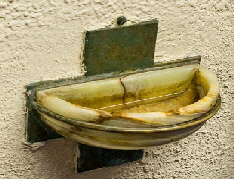|
The Entrance Vestibule or Narthex
 It is here that we enter from the noisy business of the world and recollect the presence of God before we enter into that Presence in the church proper. The vestibule or porch reminds us that we are stepping out of a noisy world and stepping into a quiet place of retreat with God. It is here that we enter from the noisy business of the world and recollect the presence of God before we enter into that Presence in the church proper. The vestibule or porch reminds us that we are stepping out of a noisy world and stepping into a quiet place of retreat with God.
Immediately inside the main entrance you will find little bowls (or 'stoups') contain Holy Water and we dip our fingers in them, and make the 'sign of the cross' to renew our baptismal promises, to prepare ourselves on entering the church, and then on leaving it to recall that we are going out to do God's work.
There is a stall, where religious items - cards, rosary beads and religious objects may be purchased (usually after weekend Masses)
You may also have noticed a collection box for food items, which are collected by our SVP Group on behalf of the Rochdale Foodbank.
|